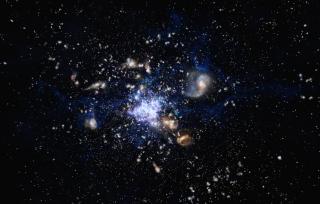Bibcode
Zhou, D.; Greve, T. R.; Gullberg, B.; Lee, M. M.; Di Mascolo, L.; Dicker, S. R.; Romero, C. E.; Chapman, S. C.; Chen, C. -C.; Cornish, T.; Devlin, M. J.; Ho, L. C.; Kohno, K.; Lagos, C. D. P.; Mason, B. S.; Mroczkowski, T.; Wagg, J. F. W.; Wang, Q. D.; Wang, R.; Brinch, M.; Dannerbauer, H.; Jiang, X. -J.; Lauritsen, L. R. B.; Vijayan, A. P.; Vizgan, D.; Wardlow, J. L.; Sarazin, C. L.; Sarmiento, K. P.; Serjeant, S.; Bhandarkar, T. A.; Haridas, S. K.; Moravec, E.; Orlowski-Scherer, J.; Sievers, J. L. R.; Tanaka, I.; Wang, Y. -J.; Zeballos, M.; Laza-Ramos, A.; Liu, Y.; Hassan, M. S. R.; Jwel, A. K. M.; Nazri, A. A.; Lim, M. K.; Ibrahim, U. F. S. U.
Bibliographical reference
Astronomy and Astrophysics
Advertised on:
10
2024
Journal
Citations
4
Refereed citations
3
Description
Context. High-redshift radio(-loud) galaxies (HzRGs) are massive galaxies with powerful radio-loud active galactic nuclei (AGNs) and serve as beacons for protocluster identification. However, the interplay between HzRGs and the large-scale environment remains unclear. Aims. To understand the connection between HzRGs and the surrounding obscured star formation, we investigated the overdensity and spatial distribution of submillimeter-bright galaxies (SMGs) in the field of 4C 23.56, a well-known HzRG at z = 2.48. Methods. We used SCUBA-2 data (σ ∼ 0.6 mJy) to estimate the 850 μm source number counts and examine the radial and azimuthal overdensities of the 850 μm sources in the vicinity of the HzRG. Results. The angular distribution of SMGs is inhomogeneous around the HzRG 4C 23.56, with fewer sources oriented along the radio jet. We also find a significant overdensity of bright SMGs (S850 μm ≥ 5 mJy). Faint and bright SMGs exhibit different spatial distributions. The former are concentrated in the core region, while the latter prefer the outskirts of the HzRG field. High-resolution observations show that the seven brightest SMGs in our sample are intrinsically bright, suggesting that the overdensity of bright SMGs is less likely due to the source multiplicity.
Related projects

Molecular Gas and Dust in Galaxies Across Cosmic Time
Two of the most fundamental questions in astrophysics are the conversion of molecular gas into stars and how this physical process is a function of environments on all scales, ranging from planetary systems, stellar clusters, galaxies to galaxy clusters. The main goal of this internal project is to get insight into the formation and evolution of
Helmut
Dannerbauer